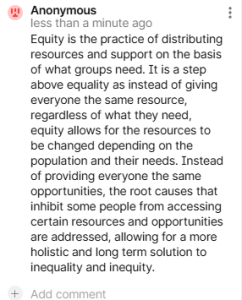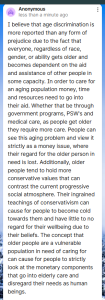6
Section One: The Fundamentals
A) Keywords
Exercise 1:
Provide a brief definition of one of the padlet keywords for this week.

|
B) The Social Significance of Aging in Sport
Exercise 2: Notebook Prompt
How is old age popularly represented today? Find an image online that you think exemplifies one defining attitude towards old age and paste in your notebook below with a brief explanation of what this image means to you.

In the current day, I believe that old age and aging are widely perceived as negative and is actively worked against by people (especially women) of all ages. Within this image, it perpetuates the current beauty fixation of “anti aging” where serums, creams, products and services are geared towards making you look as young and beautiful as possible. These current ideas surrounding aging are negative and continuously reinforce concepts of agism and discrimination. Women especially are targeted by these obsessions, and often are ridiculed by not wanting to partake in these practices, or looking “too old” for her age. Anti aging efforts have made society forget what a privilege growing old actually is, and reinforces predatory images of beauty. Anti aging campaigns have gained immense popularity throughout the years, with even girls as young as 10 wanting to participate in skin care out of the fear of aging.
|
Exercise 3: Notebook Prompt
What does the article (referencing another study by Dionigi) mean by its statement that sport can help aging people to simultaneously “accept and resist the ageing process” (572)? Respond by audio or text and find paste two images sourced online into your notebook showing how sport might help aging people to both accept and resist the aging process.
| Sport can help aging people accept and resist the aging process through accepting the fact that their physical competencies may decline, but also form a method of resistance through physical activity and sport to maintain their physical competence. Sport can help aging people acknowledge the fact that they most likely will not have the same capabilities that they had before, however it can also provide and outlet for them to continue to be active and slow the decline of physical ability.
Within these images it shows older people partaking in sport or physical activity. Within the first image, the elderly gentleman is participating in sport to help prolong his physical competency, along with recognizing as he gets older his performance may decrease also. The elderly woman behind him is participating in the same sport but at a slower pace, recognizing her abilities may decline but still participating to maintain a level of physical activity. Similarly, within the second image, the women acknowledge their ability to do rigorous physical activity is not possible, but to maintain their upper physical competence, they are lifting weighted balls in order to work out those muscles and maintain a level of physical activity.
|
Exercise 4: Notebook Prompt
Who are the groups less likely to have extensive opportunities to take part in sports, according to Pike? How does privilege factor into aging and sport? (200 words max)
| The groups that are less likely to have extensive opportunities to partake in sports are marginalized communities, people with disabilities, and the extremely frail. Privilege is a very core factor to sports participation and aging as on a base level, opportunities for older age group sports programs is already limited. If you do not live in a highly accessible, middle-class neighborhood, your chances of finding opportunities for sport are highly limited. Marginalized groups are often restricted to poorer neighborhoods and rural areas that have limited resources for them, and often cannot afford needed equipment and fees. People with disabilities who are aging face limited accessible transportation and limited assistance within recreation programs. These issues can cause them to face limited access to sports and can further decline their physical health. Extremely frail people also face the same issues and have limited programs geared to their capabilities, and are left behind in the program process. Having privilege, whether it be race, ability or money, are all components that can help an aging person access sport and maintain physical health.
|
Exercise 5: Padlet Discussion
Why do you think age discrimination is “reported more than any form of prejudice” with older people presented as a threat to social values and interests? Feel welcome to use video in your responses. Paste your comments (or transcript of your video) below!

|
B) Older Women and Sport
Exercise 6: Notebook Prompt
What differences do you see in these ads? Which one is more inclusive? How is age represented or not represented in each? Answer these questions in your notebook.
| Between the two ads, the major difference I noticed was the target audience they applied to. The first ad was geared towards all athletes of all abilities and gender. Where both men and women were shown participating in sports with differing abilities. Whereas the second ad was more for a woman audience, where women of differing physical abilities were shown participating in sports and did not focus on male athletes. The first ad had a unifying feeling to it, where the differing athletes shown doing the same movements regardless of ability or gender helped tie them together. The second ad had more of an empowerment tone to it, where the idea of “this girl can” is reinforced by presenting different women at different stages and abilities participating in sport. In the first ad, age was not really diverse in its representations. Many of the images of athletes were on the pro level, where the age group varies from 20’s – 30’s. The ad was more focused on the younger age groups and did not include aging participants. However, in the second ad, there was a more diverse range of ages depicted, along with differing levels of sport ability. People were shown of varying ages participating in sport, even if it was just lifting weights or going on a casual run. The age was more representative of both young and older athletes and participants at varying levels of athletic ability.
|
Exercise 7: Notebook Prompt
In her article, “Assessing the sociology of sport: On age and ability,” Elizabeth Pike references a “trend towards a ‘feminisation of ageing’, with many women living longer than men” (573). Do you agree that aging has been “feminized” in this way? How? Answer these questions in your notebook.
| I do believe that aging has been feminized due to women living on average longer than men. A large reason I believe this is due to the concept I addressed earlier regarding anti aging. Women are consistently shamed and belittled for their appearance and that continues well into adulthood. As women get older, they are punished by society for not appearing as they once did when they were 20/30. Due to women’s appearances being so highly surveillance by the media, their aging process is seen as ugly and something to be avoided or postponed. If males happened to live longer than women, I feel as though the perceptions of aging would be less negative, and more so geared towards empowerment, longevity and lived experience. If the dominant culture surrounding aging was male, the social perceptions of aging would be different and more positive. The feminization of aging has resulted in it being seen as a negative outcome of living life, and the physical repercussions should be limited. Additionally, aging has been feminized through the perception of older women to be care givers for their family, even in later life. The caring roll and social pressures of beauty are components contributing to the feminization of aging.
|
Section Three: Module Mini Assignment
|



